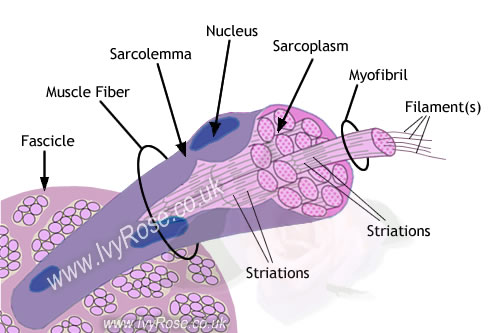Part 1: Cell Story
Hello, I am myocyte, people used to call me muscle cell as well. I can be found in your muscle tissue. I have a big family and friends: cardiac, skeletal, and smooth muscle cells, with various properties.
Cardiac can be found in your heart muscle, the major function of cardiac muscle cells is to contract so as to enable the heart to pump blood to all the parts of the body.
Skeletal are attached to bones, include the large muscles of your arms and legs, and the smaller muscles of your face. Skeletal muscle cells give power for movements, stabilize your joints and enable you to maintain an upright posture. Skeletal muscle cells come in slow-twitch and fast-twitch varieties. Slow-twitch muscle cells are adapted for endurance activities and maintaining posture. Fast-twitch muscle fibers are adapted for rapid movements and activities that require maximum efforts, such as jumping and lifting.
Smooth muscle cells can found inside blood vessels and around the pupil of the eye, perform automatic movements in the hollow organs of your body. For example, they move food through your digestive system, expel urine from your bladder and are responsible for contractions of the uterus when delivering a baby. Smooth muscle cells are also found inside blood vessels and around the pupil of the eye.

 This is my selfie and my structure.
This is my selfie and my structure.
Myocytes are long, tubular cells that develop from myoblasts to form muscles in a process known as myogenesis.
Conclusion:
We serve a remarkable variety of functions in your body, many of them occurring involuntarily. The specialized structure of the 3 types of my family in the human body enables their functional purposes. Skeletal muscle cells are primarily specialized for voluntary movements, like dancing or snapping your fingers. Smooth muscle cells are structured to produce involuntary movement, such as propelling food through your digestive system. Cardiac muscle cells keep your heart beating and have features of both skeletal and smooth muscle cells.
The Gale Encyclopedia of Medicine, edited by Jacqueline L. Longe, 5th ed., Gale, 2015.
Science In Context, http://link.galegroup.com/apps/doc/PC4205141146/SCIC?u=43riss&sid=SCIC&xid=cba8f370. Accessed 24 Apr. 2018.
Grosberg, Anna, et al. “Self-organization of muscle cell structure and function.”
PLoS Computational Biology, vol. 7, no. 2, 2011.
Science In Context, http://link.galegroup.com/apps/doc/A250677735/SCIC?u=43riss&sid=SCIC&xid=9944d1c1. Accessed 24 Apr. 2018.
Koivumaki, Jussi T., et al. “Regulation of excitation-contraction coupling in mouse cardiac myocytes: integrative analysis with mathematical modelling.”
BMC Physiology, vol. 9, 2009, p. 16.
Science In Context, http://link.galegroup.com/apps/doc/A208072933/SCIC?u=43riss&sid=SCIC&xid=4054780c. Accessed 26 Apr. 2018.
Sambrano, Gilberto R., et al. “Navigating the signalling network in mouse cardiac myocytes.”
Nature, vol. 420, no. 6916, 2002, p. 712+.
Science In Context, http://link.galegroup.com/apps/doc/A187578476/SCIC?u=43riss&sid=SCIC&xid=59e342d4. Accessed 26 Apr. 2018.
Cheng, Yuhui, et al. “Numerical analysis of [CA.sup.2+] signaling in rat ventricular myocytes with realistic transverse-axial tubular geometry and inhibited sarcoplasmic reticulum.”
PLoS Computational Biology, vol. 6, no. 10, 2010.
Science In Context, http://link.galegroup.com/apps/doc/A241629282/SCIC?u=43riss&sid=SCIC&xid=829e71a3. Accessed 26 Apr. 2018.
Part 2: The Making of the Cell Story
- What questions did you need to research in order to create your cell story?
A: “What does this cell do?”
“What is the structure of the cell?”
“How does it mutate?”
“Where is this cell found?”
“What does this cell look like?”
“Why does the host need this cell?” - What new or familiar digital tools did you try to use as you worked through this project? A: I used “Science in Context” inside “Gale Engage Learning” and “EBSCO”. We are not allowed to use Google or Youtube to do this project but I did look for information through Google and I watched some videos on Youtube just for a deeper understanding.
- What was the process you used to investigate the topic? A: I used “Science in Context” inside “Gale Engage Learning” and “EBSCO”. We are not allowed to use Google or Youtube to do this project but I did look for information through Google and I watched some videos on Youtube just for a deeper understanding.
- How did you verify and cite the information you found? A: I answered my questions with information from a variety of sources. After that, I cited all the sources I have used with embedded links to information.
- How did the process of completing this challenge go? What could you have done better? A: I had finished my project, and I found that researching on this topic is very hard on “EBSCO” and “Gale Engage Learning”, there’re less information than Google, but there’re some useful information too. Although we can’t use Google, I still got some good information for this project. I think I can write my story to be more interesting because it’s kinda boring right now. I think I can do it better next time.
Excellent information shared through your story. I like the “selfy” description of the diagram. Excellent questions guiding research. Excellent use of digital tools and perfect citing of sources. Your reflection is very honest and reflective. Fantastic work!